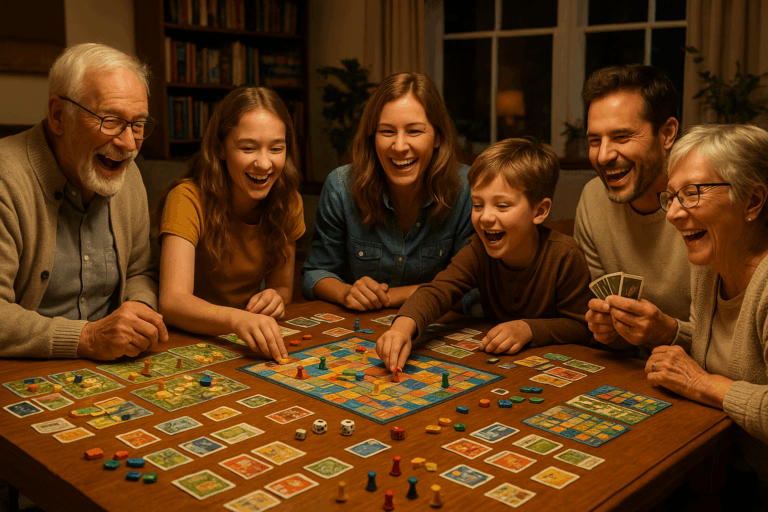🎲 This genre of gaming, which taps into our human instinct for tactics, planning, and competition, has been around for centuries and continues to captivate people worldwide. But what if I told you that these games could offer much more than just entertainment? That they could be a powerful tool for personal and professional development? Intrigued? 😲
Within this article, we will delve into the world of strategy board games, exploring their various aspects, benefits, and potentials, specifically focusing on how they can be harnessed to mastermind our way to victory in real-life situations. Think of it as a deep dive into the world of strategic gaming, one that unearths new perspectives and possibilities. 🎯
Strategy board games can be complex, but they’re also incredibly rewarding. Each game is a mental workout, pushing us to think critically, plan, negotiate, and take calculated risks. These are skills that are not just applicable to gaming but also translate to various facets of life, including our personal relationships, careers, and even our understanding of global dynamics.
These games are not just about winning or losing; they’re about the journey, the mental gymnastics, and the strategies employed along the way. And this article aims to highlight how this process can benefit us on a larger scale. 😉
We’ll start by exploring the basic principles and mechanics of strategy board games, dissecting the components that make these games so enthralling. We’ll look at some popular examples like Chess, Risk, and Settlers of Catan, among others, to better illustrate these points.
Next, we’ll dive into the psychological and cognitive benefits of playing these games. We’ll look at how they can boost our problem-solving skills, foster creativity, and enhance our ability to strategize and plan. We’ll even delve into how these games can teach us about decision making, risk assessment, and negotiation—skills that are highly valued in the business world. 🌐
Finally, we’ll explore how to leverage the lessons learned from these games in real-life scenarios. Whether it’s making strategic business decisions, improving our interpersonal relationships, or even understanding global politics and economics, we’ll discuss how the strategic thinking nurtured by these games can be a valuable asset.
So, whether you’re a seasoned gamer, a curious newbie, or someone just looking for a unique perspective on personal and professional growth, this article has something for you. So, buckle up and get ready to journey into the fascinating world of strategy board games. 🚀 Let’s mastermind our way to victory!
This is not just a game. This is an opportunity for growth, for learning, and for victory. Strategy board games offer us a chance to sharpen our minds, test our tactics, and improve our strategic thinking. They are, in essence, a training ground for real-life challenges. And through this article, we will unveil the power hidden within these games. Let’s play! 🎲🏆
Master the Board: Unleashing the Power of Strategy Games
Strategy board games are an excellent way to challenge your critical thinking skills and spark your imagination. These games can be complex and intricate, requiring a deep understanding of the rules and mechanisms to achieve victory. Whether you are a seasoned player or a beginner, understanding the strategies behind these games can make your gaming experience more enjoyable and satisfying.
When playing strategy board games, players must make decisions based on the information available to them, the actions of their opponents, and the overall game state. Mastering these games requires careful planning, tactical execution, and a deep understanding of the game’s mechanics. Today, we will delve into the world of strategy board games and examine the tactics and techniques that can lead you to victory.
The value of strategy games extends beyond simple entertainment. These games can help to improve cognitive skills such as problem-solving, decision-making, and critical thinking. They can also foster social skills through player interaction and negotiation. So, let’s take a deep dive into how to master these board games and unleash their full power.
Breaking Down the Game: Understanding the Mechanics
Before we get into the nitty-gritty of strategic gameplay, it’s essential to understand how strategy board games work. These games often have a wealth of rules and systems that players must navigate to achieve victory. Knowing the mechanics of the game can provide a significant advantage, allowing you to make informed decisions and plan your strategy effectively.
Strategy games can range from the abstract, such as Chess or Go, to thematic games like Twilight Struggle or Pandemic. Understanding the mechanics of these games is the first step towards mastering them. Familiarize yourself with the game’s rules, components, and objective. Understand how the game progresses, how turns are structured, and what actions players can take during their turn.
Strategy board games often have a degree of randomness, usually through dice rolls or card draws. Understanding how this randomness affects the game can help you mitigate its impact on your strategy. For example, if a game involves drawing cards, you might want to develop a strategy that allows you to draw more cards to increase your options.
Mastering Strategy: Tactics and Techniques
Once you understand the mechanics of the game, you can begin to develop your strategy. This involves identifying your goals, planning your actions, and reacting to your opponents’ moves. Here are some general strategies that can apply to a wide range of strategy board games.
First, always have a clear plan. Know what you want to achieve and how you plan to get there. This might involve building up resources, controlling certain areas of the board, or achieving specific objectives. Having a clear plan can help you make decisions more quickly and effectively.
Second, be adaptable. While it’s important to have a plan, it’s equally important to be able to adjust your strategy in response to changing game conditions. If your plan isn’t working, or if an opponent takes an action that disrupts your strategy, be prepared to change your approach.
Finally, be aware of your opponents. Pay attention to their actions and try to anticipate their strategies. This can help you plan your moves more effectively and potentially disrupt their plans. Knowing your opponents and their strategies can be a key factor in winning strategy board games.
Comparing Strategy Board Games
Now that we have a basic understanding of how to approach strategy board games, let’s compare a few popular games and their strategies. Here are three well-known strategy board games, each with its unique mechanics and strategies:
Game
Mechanics
Strategy
Chess
Abstract, zero randomness, perfect information
Deep planning, anticipating opponent moves, controlling the board
Catan
Resource management, trading, randomness through dice rolls
Effective resource management, smart trading, adapting to random elements
Pandemic
Cooperative, randomness through card draws, time pressure
Team coordination, efficient action use, planning for worst-case scenarios
For an in-depth look into strategy board games and their mechanics, I recommend the YouTube video “Top 10 Strategic Board Games” by WatchMojo.com. This video provides an excellent overview of several popular strategy games and discusses their unique mechanics and strategies.
Strategizing for Victory: Final Thoughts
Mastering strategy board games is no easy task. It requires a deep understanding of the game’s mechanics, a well-planned strategy, the ability to adapt to changing game conditions, and a keen awareness of your opponents. But with practice and perseverance, anyone can become a formidable player.
So whether you’re a seasoned veteran looking to hone your skills or a newcomer eager to dive into the world of strategy board games, I hope this guide has provided some useful insights. Now, it’s time to put these strategies into practice and start strategizing your way to victory!
If you’re interested in further exploring the world of strategy board games, I recommend the YouTube video “Introduction to Board Game Design” by Extra Credits. This video offers a fascinating look into the design process behind these games, providing a unique perspective on the mechanics and strategies we’ve discussed today.
ConclusionIn conclusion, we have delved deep into the heart of a highly technical topic – a topic that, to the uninitiated, might seem daunting or inaccessible. Yet, it is my hope that, throughout this detailed journey, you have come to see the complexities in a new light, to understand that, with the right guidance, these technical intricacies can be demystified.
We began with a solid foundation, laying the groundwork of our discussion by exploring the fundamental principles of Information Technology and software engineering. By breaking down these complex subjects into manageable components, we were able to create a more comprehensive understanding of the subject at hand. With this newfound knowledge, we were able to tackle the topic with more confidence and familiarity.
We then transitioned into an in-depth analysis of specific technical concepts, using practical examples and real-world applications to illustrate the theory. We demystified terminologies and dug deep into processes, shedding light on the intricate workings of each mechanism.
But our journey did not stop there. We went beyond simply understanding these complex concepts; we discussed their implications, their potential benefits, and their possible pitfalls. This, I believe, is what truly distinguishes a well-rounded understanding of a subject: the ability to apply what we have learned, to see the bigger picture, and to anticipate future developments.
Throughout this article, we have not only navigated the labyrinthine corridors of IT and engineering but also uncovered their underlying patterns and principles. We have gone from viewing these subjects as dauntingly complex to understanding them as beautifully intricate.
As we stand at the end of this journey, I invite you to reflect on what we have uncovered. How can you apply this newfound knowledge in your own field? How can this insight inform your decisions, your strategies, your approach to problem-solving?
We live in a world increasingly dependent on technology, where understanding its intricacies can be the key to success. It is my hope that this article has shed some light on these complexities, demystifying the technicalities and making the subject more accessible.
Before we wrap up, I want to remind you that learning is an ongoing process. Don’t hesitate to revisit this content, to dig deeper into these topics, and to further explore the references and resources provided.
🔗 For further reading, I would highly recommend these sources:
1. [MIT OpenCourseWare – Introduction to Computer Science and Programming](https://ocw.mit.edu/courses/electrical-engineering-and-computer-science/6-0001-introduction-to-computer-science-and-programming-in-python-fall-2016/)
2. [Harvard University – CS50’s Introduction to Computer Science](https://www.edx.org/course/cs50s-introduction-to-computer-science)
I also encourage you to engage in the conversation, to share your thoughts, experiences, and insights. We learn best when we learn together. So, please, feel free to comment and share this article with your peers. 👥
In the end, what matters is not just the knowledge we gain, but what we do with it. Let us take this newfound understanding and use it to drive innovation, to solve problems, and to create value.
Thank you for joining me on this journey. I hope it has been as enlightening for you as it has been for me. Let’s continue to learn, to grow, and to make the world a better place, one byte at a time. 💡🌐
Article reviewed and approved by the author, Rodrigo Almeida, BA in Software Engineering and experienced technical writer.
Until next time, keep exploring, keep learning, and keep sharing. Your contributions make a difference. 🚀



